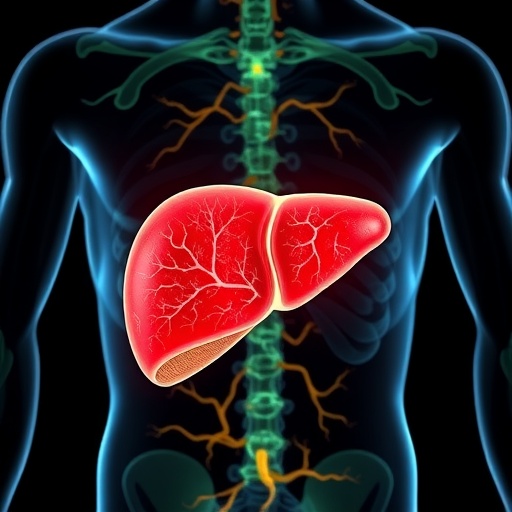Recent research conducted by Wang, S., Li, P., Guo, Z., and colleagues delves into a critical aspect of public health—namely, the intricate interplay between metabolic syndrome, specifically insulin resistance, and the rising incidence of nonalcoholic fatty liver disease (NAFLD). This groundbreaking study is rooted in data derived from the extensive United States National Health and Nutrition Examination Survey (NHANES), covering the years 2017 to 2020. In an era where metabolic comorbidities are becoming increasingly prevalent, understanding these associations is paramount for developing effective intervention strategies.
Insulin resistance serves as a pivotal risk factor for a range of metabolic disorders, including type 2 diabetes and cardiovascular disease. It signifies a diminished effectiveness of insulin in promoting glucose uptake by cells, leading to increased blood sugar levels. The metabolic score for insulin resistance (MSIR), a quantifiable metric used in this analysis, is derived from various biomarkers and clinical measures, thus providing an evaluative landscape to determine an individual’s risk level for developing insulin resistance.
A key finding of the study highlights the non-linear relationship between MSIR and NAFLD. While a direct positive correlation might be expected, the nuances of this relationship demonstrate that increases in MSIR do not uniformly correspond to increased NAFLD risk. Instead, the researchers observed that risk levels varied across population stratifications, indicating potential thresholds or shifts in risk probabilities that merit deeper exploration. This complexity in the data implicates the necessity for personalized approaches to treatment and health guidance.
Moreover, the implications of these findings extend far beyond theoretical frameworks. With NAFLD being identified as one of the most common chronic liver diseases globally, mechanisms underscoring its association with insulin resistance necessitate a concerted approach from healthcare professionals. Early identification of individuals at risk, as suggested by variations in MSIR, could facilitate timely interventions aimed at preventing the progression to more serious liver conditions such as cirrhosis or hepatocellular carcinoma.
The methodology adopted for this analysis reflects rigorous scientific standards, encapsulating a substantial cohort, which enhances the reliability and generalizability of the findings. Utilizing a population-based database like NHANES ensures that the study captures a diverse demographic, encompassing various age groups, ethnicities, and socioeconomic statuses. This inclusivity is paramount in understanding how metabolic disorders manifest differently across different segments of the population.
In light of the increasing prevalence of obesity and sedentary lifestyles, which are both contributing factors to insulin resistance, the significance of this research cannot be overstated. Public health initiatives focused on lifestyle modifications are essential; for instance, dietary interventions promoting whole foods and increased physical activity could be crucial in reversing insulin resistance and, consequently, mitigating the risks associated with NAFLD.
The non-linear dynamics identified within the study also hint at potential underlying biological mechanisms that govern the relationship between MSIR and liver health. For instance, the role of adipokines—signaling proteins secreted by adipose tissue—could play a considerable role in mediating inflammation and liver fat accumulation. Engaging in metabolic research that elucidates such pathways could prove instrumental in developing pharmacological therapies intended to target these mechanisms directly.
Another dimension worth exploring is the microbiota-gut-liver axis, which has gained attention in recent years as a possible mediator in metabolic diseases, including NAFLD. The influence of gut microbiomes on metabolic processes could serve as a potential research avenue stemming from these findings, opening doors to innovative treatment strategies that leverage dietary or probiotic interventions to improve metabolic health.
In conclusion, the research conducted by Wang et al. not only sheds light on a complex association between metabolic health and liver disease but also calls for a shift in how public health policies are shaped regarding lifestyle interventions. It is imperative that professionals within the healthcare sector stay abreast of such findings, integrating them into practice to better inform patients at risk for metabolic disorders. Through a deeper understanding of the metabolic landscape, combined with continued advocacy for healthier lifestyle choices, we can pave the way for a healthier future, ultimately diminishing the burden of NAFLD and associated health risks.
As the scientific community continues to grapple with the repercussions of metabolic syndrome and its manifestations, the work of Wang and colleagues stands out as a beacon of hope, urging us to refine our approaches and ensure that our public health strategies are informed by the latest evidence-based research. This kind of knowledge is vital as we forge ahead in combating chronic diseases tied to lifestyle and metabolic dysfunctions.
With such extensive implications, the call for further studies examining the intersection of metabolic health and liver disease is clear. Continued investigation will not only bridge gaps in understanding but also foster the development of effective therapeutic measures aimed at this critical intersection of health.
Subject of Research: The non-linear association between metabolic score for insulin resistance and nonalcoholic fatty liver disease.
Article Title: Non-linear association between metabolic score for insulin resistance and nonalcoholic fatty liver disease: analysis of US National health and nutrition examination survey data, 2017–2020.
Article References:
Wang, S., Li, P., Guo, Z. et al. Non-linear association between metabolic score for insulin resistance and nonalcoholic fatty liver disease: analysis of US National health and nutrition examination survey data, 2017–2020. BMC Endocr Disord 25, 172 (2025). https://doi.org/10.1186/s12902-025-01988-z
Image Credits: AI Generated
DOI: 10.1186/s12902-025-01988-z
Keywords: Insulin resistance, nonalcoholic fatty liver disease, metabolic syndrome, public health, NHANES, lifestyle interventions.




